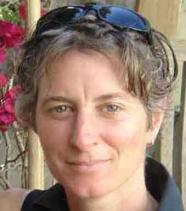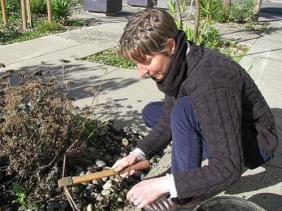This fall SPUR has featured the projects of local "Do-It-Yourself" urbanists in DIY Urbanism: testing the grounds for social change. In lean economic times, individuals have become the driving force behind some of the most successful initiatives to make San Francisco a better city, often providing the crucial impetus to address problems on a larger scale.


SPUR spoke with Jane Martin, whose image as a jack-hammer wielding advocate for greener sidewalks has made her emblematic of the do-it-yourself spirit. Jane is a local designer, professor and founder of PlantSF, a non-profit which helps homeowners turn excess concrete into exposed-earth gardens.
Many San Franciscans are familiar with sight of sidewalks up to and over 20 feet in breadth. Such expanses of impermeable surface are are hostile to essential natural processes, exacerbating stormwater runoff, air pollution and urban heat islands.

Since moving to San Francisco's Mission district, Jane had struggled to secure a permit to convert some of the excess concrete around her home into usable green space. Such sidewalk plantings would serve not only to beautify the neighborhood, but also to help relieve the overburdened city stormwater facilities, allowing rain to filter into the soil rather than runoff over streets accumulating pollution.
Jane was motivated to action by her principles and her passion, but also by poop. After several storms overloaded the city's septic system, inundating her basement with sewage with nowhere else to go, Jane decided she'd had enough. "That was the big moment" she said, "being knee deep in fecal water and realizing the ground beneath my feet was dry."
Jane worked with the local government to establish a sidewalk planting permitting process that was navigable and affordable. She founded PlantSF in 2004 to continue providing information to individuals interested in reestablishing a connection to the earth outside their own doorsteps.

Prior to her advocacy, "a permit process did not exist." But Jane was encouraged by the City's receptiveness to her proposal. "Convincing people took quite a bit less effort than I expected" she said, and it went really smoothly once we set on doing it. Traditional agency divisions are counterproductive, so it takes mindful collaboration to overcome that. Fortunately some really terrific people were involved."
Thanks to Jane, interested individuals can now apply for sidewalk plantings through a streamlined process (forms available here), marked down from over $800 to just over $100.
The image of Jane literally "taking a jackhammer to the sidewalk outside her own home" embodies the Do-It-Yourself ideal. Yet it seems that the work of installing permeable landscaping actually involves a web of partnerships with neighbors, local non-profits, and city agencies. Jane's response highlights one of the main features of DIY, that it involves not a rejection of government involvement, but a more porous relationship between grassroots activists and City-directed initiatives. "Ideally this would be a city-wide program and not rely on DIY for the main part of making the earth available," Jane concedes, "but we are a town of committed individualists which in this case works against us. We lose out on many benefits because of a lack of coordination."
The government has a critical role to play in altering the current regime of stormwater management through its ability to implement master plans and direct vast resources. "People can still do their own," says Jane, "but it should be in a framework that has been well thought through by the many terrific engineers, geologists and other specialists the City employs."
Jane has joined the ranks herself, as an appointee to Mayor Newsome's Commission on the the Environment. "During my time on the commission we have addressed quite a broad range of issues, including: sustainable development, cell phone radiation, dark skies, bird-building strikes, energy efficiency, green building standards, pharmaceutical disposal and more."
Having gone from a private citizen activist to a member of the mayor's Commission on the Environment and the leader of PlantSF's ambassadorial services, Jane is uniquely positioned to comment on private-public partnerships. To others interested in changing aspects of their community, but intimidated by bureaucratic barriers, Jane says: "Get involved. Contribute your strengths and recognize your weaknesses. Work with people instead of against them. Recognize that everyone has a perspective."

According to PlantSF, Permeable Landscaping provides the following benefits:
• Reduces storm sewer loads, reducing potential for backups and flooding;
• Beautifies the neighborhood;
• Creates opportunities for community interaction;
• Deters crime;
• Increases property values;
• Reduces global warming (by absorbing heat rather than reflecting it);
• Increases oxygen production; and
• Recharges ground water.
• Creates habitat for birds, butterflies and other wildlife;
• Makes a place to garden;
• Provides potential for urban farming (foodscape);
PlantSF is currently performing demonstration projects in the Sunset district and will be in Noe Valley in 2011. People can check in on www.plantsf.org to learn more and to see the latest projects and to begin their own!
DIY Urbanism: Testing the grounds for social change, now on show at SPUR's Urban Center, features innovative "do-it-yourself" projects, providing a snapshot of this burgeoning and distinctively local movement.
Photo Credit: All photos via PlantSF